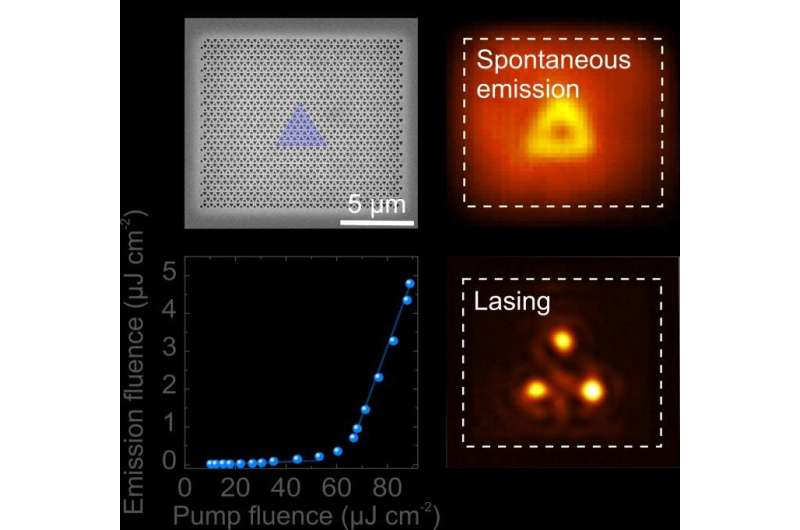Valley Hall nanoscale lasers developed

Topological photonics underpins a promising paradigm for robust light manipulation, as well as smart design of optical devices with improved reliability and advanced functionalities that are governed by the nontrivial band topology. Nanostructures made of high-index dielectric materials with resonant elements and lattice arrangements show special promise for implementation of topological order for light at the nanoscale and optical on-chip applications. High-index dielectrics such as III-V semiconductors that can contain strong optical gain further enhanced by topological field localization form a promising platform for active topological nanophotonics.
In a new paper published in Light Science & Application, a team of scientists, led by Yuri Kivshar from the Australian National University and Hong-Gyu Park from the Korea University, and co-workers have implemented nanophotonic cavities in a nanopatterned InGaAsP membrane incorporating III-V semiconductor quantum wells. The nanocavities exhibit a photonic analog of valley Hall effect. Researchers demonstrated room-temperature low-threshold lasing from a cavity mode hosted within the topological bandgap of the structure.
The SEM image of the fabricated structure and experimental results are shown in the image. The cavity is based on the closed valley Hall domain wall created by inversion of staggering nanoholes sizes in a bipartite honeycomb lattice. In the topological bandgap frequency range, the cavity supports a quantized spectrum of modes confined to the domain wall. The images show real-space emission profiles below and above the threshold.
The scientists explain:
"In experiment, we first observe spontaneous emission from the cavity. The emission profile shows the enhancement along the entire perimeter of the triangular cavity associated with edge states. When increasing a pump power, we observe a threshold transition to lasing with a narrow-linewidth where the emission gets confined at the three corners."
When two spots are isolated, coherence of the emission is confirmed by interference fringes observed in the measured far-field radiation patterns. An isolated corner emits a donut-shaped beam carrying a singularity. These findings make a step topologically controlled ultrathin light sources with nontrivial radiation characteristics.The researchers forecast:
"The proposed all-dielectric platform holds promise for the versatile design of active topological metasurfaces with integrated light sources. Such topological nanocavities has vast potential for advances in nonlinear nanophotonics, low-power nanolasing and cavity quantum electrodynamics."
More information: Daria Smirnova et al, Room-temperature lasing from nanophotonic topological cavities, Light: Science & Applications (2020).
Journal information: Light: Science & Applications
Provided by Chinese Academy of Sciences




















